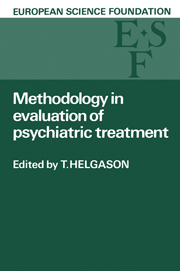 Methodology in Evaluation of Psychiatric Treatment
Methodology in Evaluation of Psychiatric Treatment from III - RATING METHODS IN EVALUATION OF TREATMENT
Development of the AMP system
In 1965 the Association for Methodology and Documentation in Psychiatry (AMP) was founded by several German-speaking psychiatrists from Germany, Switzerland and Austria (Angst et 0/1969). It was the aim of these psychiatrists to develop together a system for the documentation of psychopathological and somatic symptoms which are characteristic for the description of psychiatric patients. In 1971 the first edition of the AMP manual was published (Scharfetter 1971), followed by the second edition in 1972 (Scharfetter 1972). This manual contained a detailed description of every item, especially of the psychopathological symptoms. In 1979 the third, revised edition of the manual was published and the name of the system was changed to AMDP (AMDP 1979). One of the reasons for this change was to prevent further confusion with cyclic AMP. Equally important was the wish to emphasize that the new version of the system has been the result of many years of methodological work and many intense discussions.
Today the new edition of the AMDP system has been used in several hospitals for the routine documentation of psychiatric patients, especially in Berlin and Munich. Methodological examination of the new version for example, of the inter-rater reliability or the construction of subscales is not finished. For the moment it is, therefore, impossible to give a detailed synopsis of the AMDP system. In this situation I will concentrate on the following subjects: 1. Training of raters; 2. Instructions for raters; 3. Development of AMP short forms, especially two second-order scales, which will most probably survive the change from AMP to AMDP; 4. Comparison between AMDP system and other well-known rating scales.
During the last AMDP meeting in 1980 it was reported that the system has been translated into 11languages (Baumann & Faehndrich 1981). One of these translations has given me a lot of help in preparing this paper: ‘The North American Adaptation of the AMDP System’ by William Guy and Thomas Ban (in preparation).
Description of the AMDP assessment documents
AMDP consists of five integrated parts, each printed on a single sheet of paper: 1. Anamnesis - Demographic data; 2. Anamnesis - Life events; 3. Anamnesis - Historical data; 4. Psychopathological symptoms; 5. Somatic signs. This paper concentrates on parts 4 and 5, the rating of psychopathological and somatic symptoms.
To save this book to your Kindle, first ensure [email protected] is added to your Approved Personal Document E-mail List under your Personal Document Settings on the Manage Your Content and Devices page of your Amazon account. Then enter the ‘name’ part of your Kindle email address below. Find out more about saving to your Kindle.
Note you can select to save to either the @free.kindle.com or @kindle.com variations. ‘@free.kindle.com’ emails are free but can only be saved to your device when it is connected to wi-fi. ‘@kindle.com’ emails can be delivered even when you are not connected to wi-fi, but note that service fees apply.
Find out more about the Kindle Personal Document Service.
To save content items to your account, please confirm that you agree to abide by our usage policies. If this is the first time you use this feature, you will be asked to authorise Cambridge Core to connect with your account. Find out more about saving content to Dropbox.
To save content items to your account, please confirm that you agree to abide by our usage policies. If this is the first time you use this feature, you will be asked to authorise Cambridge Core to connect with your account. Find out more about saving content to Google Drive.